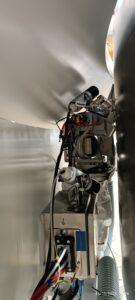Laser Cleaning of VVER-Type Reactors
Request
The aim of the project was to design and deliver a system for laser cleaning of a VVER-
440 type 213 nuclear reactor. The reason for cleaning the reactor vessel was the need for
regular ultrasonic inspections, which are not possible if contaminants are present on the
vessel’s surface—as they prevent ultrasound from penetrating through to the material.
A major technological challenge was the limited space—there is only a 30 cm gap between
the vessel and the concrete containment wall..
Solution
Due to the spatial constraints of the laser operation, LASCAM systems and Elya solutions designed a unique laser process head that, thanks to its geometry, could fit precisely into the narrow space between the reactor vessel and the containment structure.
The process naturally releases corrosion particles from the reactor vessel surface. It was therefore essential to ensure efficient extraction of these particles. To that end, a custom-designed extraction duct manufactured using laser sintering was integrated into the system. In addition to extracting particles, it also served as a protective element to prevent deposits from accumulating on the laser optics.
The system proved to be so robust that it enabled full cleaning of the reactor vessel without the need for service. Considering work safety and the fact that the maximum allowed outage time of the nuclear block was only 10 days, this maintenance-free solution was absolutely crucial. Within that time, the entire system was successfully installed, the reactor vessel cleaned, and the workplace restored to its original state.
Finally, it is important to note that the system operates completely autonomously, without operator access and in total darkness. For this reason, the laser cleaning head was equipped with multiple sensors for remote diagnostics and system management, as well as a vision system for real-time process control.
Results
- Non-contact and non-abrasive cleaning of the reactor vessel
- Very fast installation, cleaning, and removal of the system during the nuclear block’s planned outage
- Sophisticated remote management, diagnostics, and process control
- Faster and more efficient cleaning than conventional brushing methods

